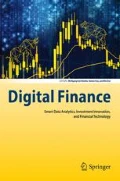Nowadays, you need to do Machine Learning and something with Cryptos to either raise budget or be invited to speak on a Quantitative Finance conference. Consequently, we started including these topics in the annual MathFinance Conferences and invited speakers and participants of the MathFinance Conferences 2020 and 2021 to submit their work to this special issue, but also accepted other contributions from the community. As a result, we composed the four papers:
-
Default Analysis in Mortgage Risk with Conventional and Deep Machine Learning Focusing on 2008–2009
-
Accuracy of Deep Learning in Calibrating HJM Forward Curves
-
Cryptocurrency Volatility Markets
-
Delta Force: Option Pricing with Differential Machine Learning
Traditionally, Quantitative Finance has revolved around the development of parsimonious models that yield some economic understanding of financial markets. In recent years, there has been a change in this paradigm by embracing data-driven methods from AI and ML. Reasons to explain this shift include (1) greater amounts of financial data are available that require fast processing; (2) financial analysis and computations are supplemented by non-financial data, such as textual data, to create new insights; (3) data-driven methods allow to detect trends and market changes that would not be observed with a rigid model. At the same time, platform technology has taken over trading of spot and derivatives in financial markets. Pricing models, Greeks and risk calculation must be faster and more accurate than ever before. Quants now think about how to hedge exotics portfolios, how to fill missing data in volatility surfaces, how to price crypto currency derivatives, and platforms are creating workspaces to analyze financial products.
We thank the contributing authors and referees, in particular David Belay to make this special issue happen and look forward to seeing more of your contributions on the MathFinance Conference in the upcoming years, maybe also guarding our human intelligence (HI), as Karel in’t Hout would phrase it, and let not get everything artificial after all.
The four papers in this special issue reflect the fundamental changes that Quantitative Finance is undergoing. Jeonghee Lee and Vikram Ojha use Machine Learning to investigate the links between loan characteristics and their default behaviour. Fred Espen Benth, Nils Detering and Silvia Lavagnini introduce a class of state-dependent volatility operators with the purpose of providing a fast and accurate calibration of energy options to an infinite-dimensional HJM-framework with deep neural networks. Fabian Woebbeking develops a volatility index for cryptocurrencies and investigates crypto volatility during the Covid-19 crisis. The paper by Magnus Grønnegaard Frandsen, Tobias Cramer Pedersen and Rolf Poulsen is devoted to the calculation of deltas when simulating option prices, demonstrating two methods of delta-regularization: polynomial regression and using deep neural networks.
The line-up of papers and their diverse applications prove that Machine Learning methods in Quantitative Finance are here to stay.
Prof. Dr. Natalie Packham, Berlin School of Economics and Law
Prof. Dr. Uwe Wystup, Managing Director, MathFinance AG–Frankfurt/Singapore
Author information
Authors and Affiliations
Corresponding author
Rights and permissions
About this article
Cite this article
Packham, N., Wystup, U. Special Issue on Artificial Intelligence, Machine Learning and Platform Innovation in Quantitative Finance (MathFinance Conference 2020/2021). Digit Finance 3, 207–208 (2021). https://doi.org/10.1007/s42521-021-00043-5
Accepted:
Published:
Issue Date:
DOI: https://doi.org/10.1007/s42521-021-00043-5

